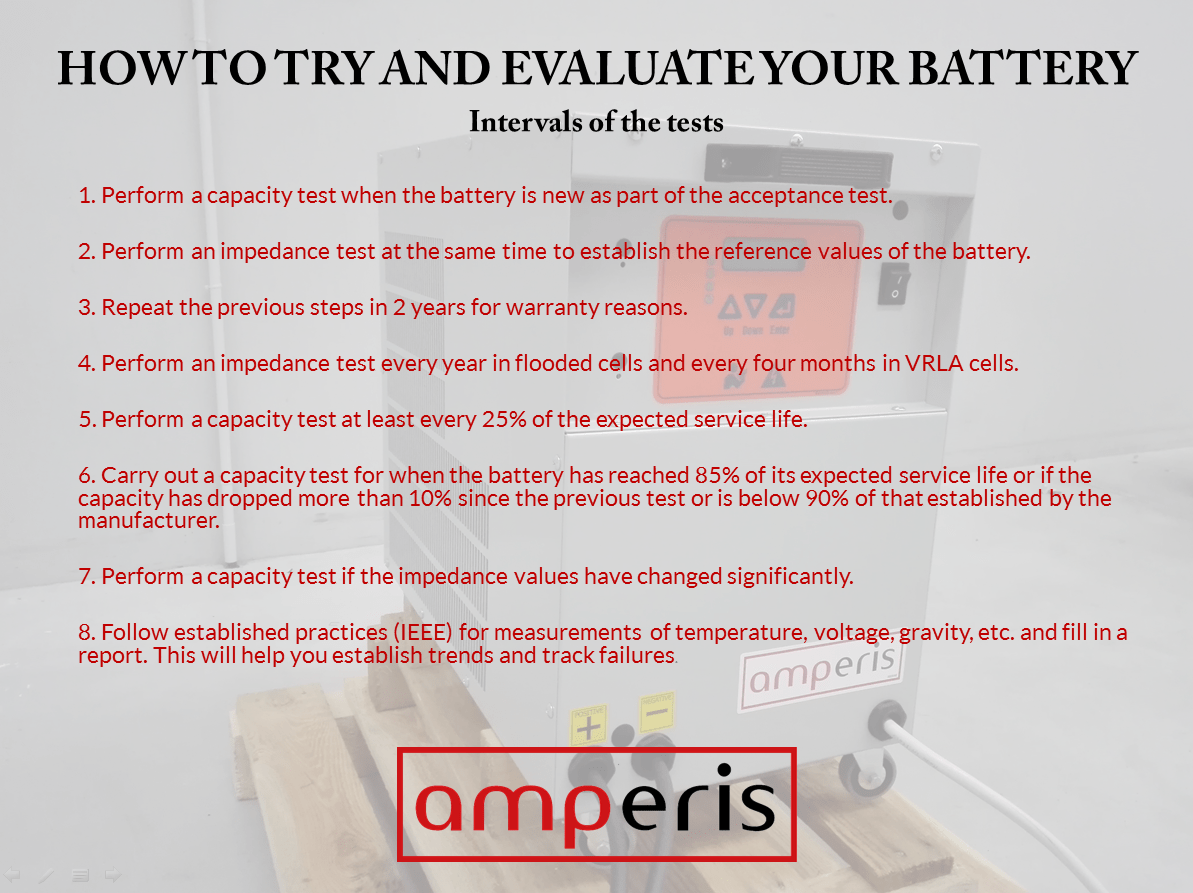How to test and evaluate your battery
Industrial battery chargers are entering a new phase, with more efficient developments and with a technology that combines energy efficiency with robustness and flexibility. The objective of these improvements, in terms of equipment innovation, is to reduce the carbon footprint and save energy.
The new multi-frequency chargers from Amperis are industrial battery chargers capable of measuring their energy consumption, the savings achieved in energy (kWh), cost ($) and the associated carbon emission (amount of CO2). The great advantage of these chargers is the combination of energy efficiency and the possibility of using it in industrial applications of any type and complexity. The clock in real time and the calendar incorporated in the charger, allows programming all the time-dependent functionalities.
The increase in temperature of the battery that usually happens at the end of each charge cycle, is reduced thanks to the application of high intensity controlled pulses that agitate the electrolyte efficiently. As an advantage of the use of this technology, one is achieved:
- reduction of water consumption of the battery
- improved battery efficiency
- extending the life of the battery
- suppression the risk of sulfation of the battery

But without a doubt all this does not make sense to carry out maintenance tasks according to these purposes. There are several maintenance philosophies that depend on the level of ambition applied to the battery test. The best maintenance action is one that balances the risk of losing the battery and the equipment supported and the maintenance costs. As an example, we can have a substation through which millions of euros flow, and a battery has a cost of 2000 euros, its maintenance is minimal compared to losses due to a failure.
There are a series of good business practices and standards for battery maintenance, thanks to which inspections and capacity tests are carried out to preserve the integrity and good condition of the battery:
- The IEEE 450 standard defines recommended practices for maintenance, testing and replacement of flooded lead-acid batteries in stationary applications. This standard describes the measures necessary to validate the condition of the battery, as well as the replacement criteria, the frequency of capacity tests, corrective actions, etc.
* Monthly inspections that include ripple current and voltage, charger output current and voltage, temperature, float charge current, etc.
* Inspections every four months. They include the same measurements in addition to the voltage of each cell, specific gravity of 10% of the cells of the battery and floating charge current, temperature of a sample representative of 10% or more of the cells of the battery.
* Annual inspection
Capacity test (discharge test): It is performed in the installation in the first years of service, also called acceptance test. After periodically, it must be performed at least 4 times during the expected battery life. It is carried out annually when the batteries are degraded or reached 85% of the expected useful life.
The degradation of the battery is perceived when its capacity drops more than 10% of the previous tests or drops by 90% of what the manufacturer stipulates. This test allows the battery to be tested every 2 years if it does not show signs of degradation and if it reaches 85% of its useful life, it responds as required by the manufacturer.
https://standards.ieee.org/findstds/standard/450-2010.html
- The IEEE 1188 standard defines the recommended practices, frequency and type of measurements necessary for maintenance, testing and replacement of valve-regulated lead-acid batteries for stationary applications.
* Monthly inspections that include battery terminal float voltage, temperature, voltage and current of charger output, etc.
* Inspections every four months. They include the same as the monthly tests and the higher the cell / unit impedance, the voltage of each cell and the negative terminal temperature of each cell.
* Semi-annual and annual measurements are also made
Capacity test (discharge test): It is performed in the installation in the first years of service, also called acceptance test. After periodically, it must be performed at least 4 times during the expected battery life. And when the impedance values have been modified between previous readings or when physical changes occur. It is carried out annually when the batteries are degraded or reached 85% of the expected useful life.
https://standards.ieee.org/findstds/standard/1188-2005.html
- The IEEE 1106 standard defines recommended practices for maintenance, testing and replacement of ventilated nickel-cadmium batteries for stationary applications
* In this case, the inspections are carried out every four months, analyzing the appearance of the battery, the electrolyte temperature, the floating voltage of the terminal, the voltage and the output intensity of the charger.
* On a semi-annual basis, general inspections are carried out.
The capacity test is performed in the first 2 years of service and at intervals of 5 years until the battery loses capacity.
https://standards.ieee.org/findstds/standard/1106-2015.html
Both standards, IEEE450 and IEE1188, set the maximum replacement time of one year when the capacity of the battery is less than 80% of that stipulated by the manufacturer. The complete change or only concrete cells will be determined by the conditions of the plate or high temperatures.
Ask us any questions regarding the maintenance of your battery. We are experts in extending the life of industrial batteries.
